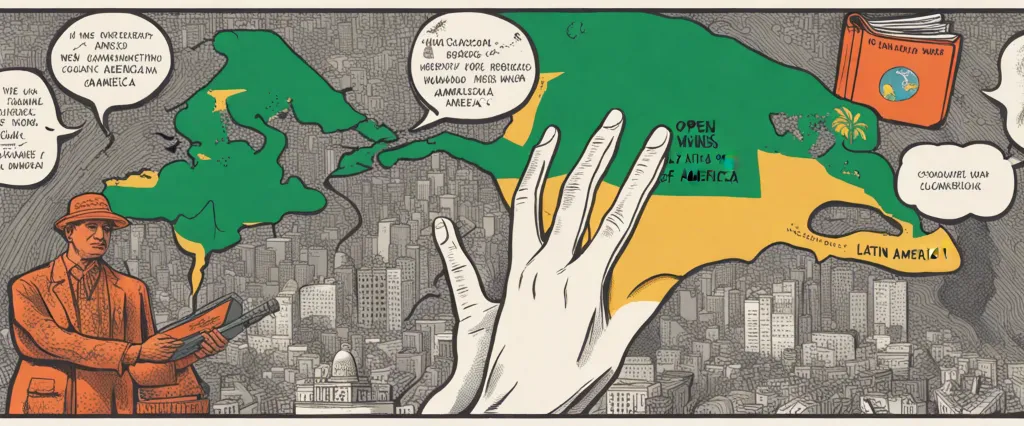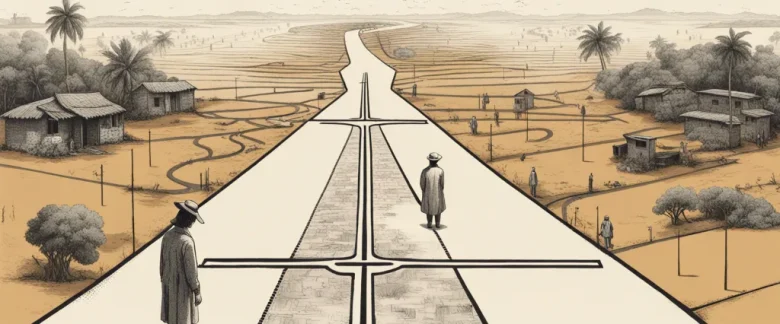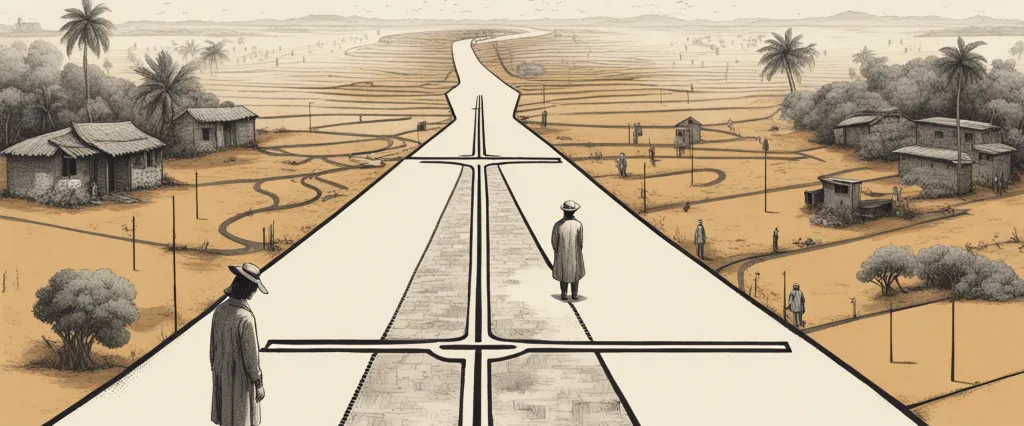In “Open Veins of Latin America” by Eduardo Galeano, the complex history of the region unfolds through the exploration of its economic and political dynamics. Published in 1971, this seminal work aims to expose the exploitative practices that have plagued Latin America, leading to its continued subjugation and underdevelopment. Galeano, born in Uruguay in 1940, was a renowned journalist, historian, and writer known for his profound commitment to social justice and the pursuit of truth. Through his engaging narrative style and comprehensive research, Galeano sheds light on the underlying causes of Latin America’s ongoing struggles, tracing the exploitative patterns that have shaped the continent’s past and continue to shape its present reality.
Chapter 1: The Open Veins
Chapter 1: The Open Veins of the book Open Veins of Latin America by Eduardo Galeano lays the groundwork for understanding the historical exploitation and pillaging of the continent by European colonizers. The author takes the reader on an exploration of the vast resources of Latin America that had fueled the development and growth of the Western European powers, mainly Spain, Portugal, England, France, and Holland.
Galeano begins by revealing the enormity of the wealth Latin America possessed, including gold, silver, precious gems, and labor-intensive crops like sugar and cotton. He emphasizes that this abundance was a magnet for the colonizers, who saw the continent as a source of limitless riches. With a vivid narrative style, the author describes the ruthless and violent conquests of the indigenous peoples by the Europeans, who used brutal tactics and forced labor to exploit the region’s resources.
However, the consequences of this extraction were not limited to the simple transfer of wealth from Latin America to Europe; rather, it led to the profound underdevelopment and dependency of the continent. Galeano elucidates how the systematic exploitation disrupted the economic, social, and political structure of Latin America, leaving it predominantly poor, weak, and at the mercy of external powers.
By the end of the chapter, Galeano highlights the cycle of poverty that emerged and persisted due to Latin America’s economic dependence on Europe and the United States. He argues that these external powers continued to dominate and control the region through financial institutions, political influence, and unequal trade relationships.
Through Chapter 1, Galeano sets the stage for a comprehensive analysis of Latin America’s historical exploitation, providing a critical perspective on the root causes of the region’s economic underdevelopment.
Chapter 2: The Indian Problem
Chapter 2: The Indian Problem of Eduardo Galeano’s book, Open Veins of Latin America, delves into the history of indigenous peoples in Latin America and the devastating consequences they faced due to colonization, exploitation, and annihilation.
Galeano begins by highlighting the significant presence of indigenous communities in pre-Columbian times, a rich and diverse culture that existed long before the arrival of Europeans. However, the conquest of the Americas by the Spaniards initiated a systematic process of extermination and enslavement of indigenous populations. The Europeans sought to impose their domination, exploit resources, and impose their own culture and religion upon the native people.
The chapter meticulously portrays the profound injustice suffered by indigenous communities. They were subjected to extreme violence, forced labor, and the pillaging of their lands and resources. Galeano exposes how the conquistadors exploited the Indians, extracting immense wealth in the form of gold, silver, and precious minerals.
The author demonstrates how the Europeans’ ruthless pursuit of wealth and power brought about a catastrophic decline in the indigenous population. Millions of indigenous people died due to harsh working conditions, diseases brought by the Europeans, and forced migrations. The loss of native land, natural resources, and cultural heritage further marginalized indigenous communities, forcing them into poverty and subjugation.
Galeano asserts that the Indian problem, as he terms it, is not a thing of the past but an enduring issue that Latin America continues to grapple with. The indigenous people have been denied their rightful place in society, marginalized and excluded from political, economic, and social structures. Their struggle for recognition, land rights, and cultural preservation continues to this day.
In conclusion, Chapter 2 vividly depicts the tragic history of the indigenous peoples of Latin America, who were victimized by colonization and its ruthless consequences. Galeano serves as a powerful voice, shedding light on the ongoing Indian problem, calling for justice and recognition for these marginalized communities.
Chapter 3: The Gold and the Cross
Chapter 3 of “Open Veins of Latin America” by Eduardo Galeano is titled “The Gold and the Cross.” In this chapter, Galeano illustrates the devastating impact of European colonization on indigenous communities in Latin America.
The chapter begins by exploring the history of gold, which became the driving force behind the conquest and colonization of Latin America. The Spaniards, in search of this precious metal, initiated a brutal process of exploitation that resulted in the plundering of indigenous resources. Galeano describes how the indigenous people of this region, particularly the Aztecs, Incas, and Mayans, had developed advanced metallurgical techniques and used gold for religious and cultural purposes. However, the arrival of the Spanish conquistadors turned this resource into a symbol of oppression.
Galeano exposes the violence and cruelty inflicted by the Spaniards upon the indigenous communities in their quest for gold. The native people were subjected to enslavement, forced labor, and severe punishment if they did not comply. Moreover, the arrival of diseases such as smallpox, brought over by the Europeans, further decimated the indigenous populations, leading to mass death and suffering.
The author also explores the role of religion, particularly Catholicism, in the colonization process. The Spanish conquest was not only driven by economic motives but also by the desire to spread Christianity. The cross, symbolizing the arrival of the Catholic faith, was brought alongside the sword, resulting in a profound clash of cultures and the suppression of indigenous beliefs and practices.
Overall, Chapter 3 highlights the horrific consequences of European colonization on the indigenous people of Latin America. The lust for gold and the imposition of European culture reshaped the region, leading to the destruction of indigenous societies, loss of indigenous knowledge, and the exploitation of its people and resources.
Chapter 4: The Slavery of Sugar

Chapter 4: The Slavery of Sugar from the book “Open Veins of Latin America” by Eduardo Galeano explores the brutal exploitation and enslavement endured by the Indigenous and African populations during the era of the sugar plantations.
The chapter begins by describing the establishment of sugar production in the Caribbean islands by European powers, primarily Spain and Portugal. Galeano illustrates how this industry fueled the rampant colonization, slavery, and genocide in the region. The author emphasizes that the so-called “discovery” of America by Columbus only brought about suffering for the indigenous peoples, who were forced into labor on the sugar estates and subjected to ruthless exploitation by the conquistadores.
Galeano highlights the harsh conditions endured by the enslaved laborers, who were treated as commodities and subjected to physical, emotional, and sexual abuse. The sugar plantations became centers of cruelty and human suffering, as Europe’s insatiable demand for sugar led to the continual capture and transport of African slaves to work in these fields.
Furthermore, the author explores the economic dynamics behind the sugar trade, including the global reach of the sugar industry and its integration into the capitalist system. He analyzes how profit-driven European countries, notably England, utilized state power and monopolistic practices to control the entire sugar production process, from cultivation to refining.
Throughout the chapter, Galeano condemns the sugar industry’s inhumane practices and the systemic violence it perpetuated. He argues that the extractive and exploitative nature of this industry laid the foundation for the subsequent underdevelopment and poverty that continues to plague Latin America.
In essence, “The Slavery of Sugar” eloquently portrays the nightmarish reality faced by indigenous and African populations in the sugar plantations, shedding light on the historical roots of economic inequality and social injustice in Latin America.
Chapter 5: The British Challenge
Chapter 5 of “Open Veins of Latin America” by Eduardo Galeano, titled “The British Challenge,” explores the economic and political influence of Britain on Latin America during the 19th and early 20th centuries.
The chapter begins by discussing how Britain became the first nation to industrialize, leading to a significant increase in demand for raw materials. Latin America, with its vast reserves of minerals, such as gold, silver, and copper, became a target for British exploitation. Galeano argues that Britain’s imperialistic approach aimed to extract these natural resources while keeping Latin America in a state of dependence.
The author describes how British companies established dominance in various sectors, such as mining, railways, and ports, effectively controlling the region’s economy. They brought in advanced technology but exploited the abundant yet cheap labor force, leading to the further enrichment of British capitalists at the expense of Latin American workers.
Galeano also highlights how Britain’s political influence played a significant role, often intervening to protect its interests. He recounts examples of British involvement in conflicts within Latin America, including the armed intervention in Argentina and the support for the Brazilian monarchy.
Furthermore, the author delves into the debt system that emerged from British influence. Latin American countries, eager to develop and catch up with the industrialized world, borrowed heavily from British banks to fund infrastructure projects. However, Galeano argues that this led to a cycle of perpetual indebtedness, as the interest payments kept draining the region’s resources. This debt burden continued to weigh down Latin American countries for generations.
In summary, Chapter 5 of “Open Veins of Latin America” examines the British challenge to Latin America, highlighting their economic dominance, political intervention, and the detrimental effects of the debt system. The chapter portrays how British colonialism facilitated the exploitation of Latin America’s natural resources and perpetuated its dependence on foreign powers.
Chapter 6: The United Fruit Company
Chapter 6 of “Open Veins of Latin America” by Eduardo Galeano examines the exploitative practices of the United Fruit Company (UFC) within the region. The chapter delves into the history and operations of the company, highlighting its impact on Latin American countries and the lives of its workers.
Galeano describes how the UFC, an American multinational corporation, gained control over vast stretches of land in various countries, particularly in Central America. The company manipulated local governments, frequently obtaining wide-ranging concessions and subsidies. By monopolizing the banana industry, the UFC became a dominant force, determining prices and dictating national economic policies.
The author exposes the dark side of the UFC’s operations, with workers enduring appalling conditions. Employees faced harsh labor regimes, with long hours, low wages, and an absence of labor rights. The corporation utilized a divide-and-rule strategy to suppress worker uprisings, fostering dependency and undermining trade unions.
Galeano also reveals the UFC’s strong ties to US governments, which often intervened in Latin American politics to ensure the company’s interests were protected. The US military repeatedly intervened, including the infamous 1954 coup in Guatemala against President Jacobo Árbenz, who attempted to challenge United Fruit’s dominance.
The chapter highlights how the UFC’s practices had devastating consequences for Latin American societies. Banana plantations ravaged the environment through deforestation and the use of harmful pesticides. The company’s profits predominantly flowed out of the region, further deepening economic dependency.
Overall, Chapter 6 of “Open Veins of Latin America” presents the United Fruit Company as a symbol of imperialism and exploitation, revealing the systemic injustices perpetuated by multinational corporations in their pursuit of profits, while depicting the toll it takes on the region’s people and resources.
Chapter 7: The Contemporary Era
Chapter 7: The Contemporary Era of the book Open Veins of Latin America by Eduardo Galeano provides a comprehensive examination of the economic, political, and social challenges faced by Latin America in the 20th century.
Galeano starts by analyzing the impact of the Great Depression on the region, which exacerbated its dependence on exported raw materials and debt to foreign powers. He highlights how these economic woes were further aggravated by corrupt political systems and despotic governments, which ultimately led to the emergence of military regimes in several countries.
The author delves into the exploitation of natural resources by multinational corporations, which resulted in significant environmental degradation and destruction of indigenous territories. He explores the extraction of oil, minerals, and other raw materials, emphasizing how these resources often ended up benefiting foreign companies, leaving the local population trapped in poverty.
Galeano also pays close attention to the role of the United States in Latin American affairs. He examines interventions and sponsorships of dictatorial regimes in countries such as Chile, Argentina, and Nicaragua, highlighting the destructive consequences suffered by the local populations.
Furthermore, the chapter sheds light on the inequality and marginalization faced by women in Latin America during this era. Galeano acknowledges the tireless efforts of feminist movements and individuals fighting for gender equality, as well as focusing on the struggles faced by indigenous and peasant women.
Overall, Chapter 7 of Open Veins of Latin America offers a comprehensive overview of the challenges faced by the region in the 20th century. Galeano exposes the exploitative nature of economic systems, the interference of foreign powers, and the fight for social justice, ultimately highlighting the cyclical patterns of oppression and resistance that have plagued Latin America throughout its history.

Chapter 8: The Resurrection of the Veins
Chapter 8 of “Open Veins of Latin America” by Eduardo Galeano, titled “The Resurrection of the Veins,” explores the reinvigoration of the veins of Latin America, symbolizing the ongoing exploitation and suffering of its people and resources.
The chapter begins by examining the massive mining operations that took place in the region after World War II. Galeano describes how Latin America became a source of raw materials for industrial nations, leading to intensified extraction and increased exports of minerals. However, this extraction was not carried out for the benefit of Latin American people; rather, it further enriched already powerful foreign companies and governments, perpetuating a cycle of economic dependence.
Galeano then delves into the agricultural sector, highlighting the rise of large landowners and agribusinesses that profited from exploiting cheap labor and vast stretches of land. Latin America turned into a vast plantation, producing cash crops like coffee, rubber, and bananas. This agricultural dominance came at the expense of indigenous communities, peasants, and workers who were subjected to harsh working conditions, low wages, and land displacement.
The author goes on to discuss the similarities between the past and the present regarding the exploitation of Latin America’s natural resources by foreign powers. He examines the oil industry, where multinational corporations dominated the extraction and refining processes, ensuring the profits were repatriated rather than invested in local communities. Similarly, he explores how Latin America is still being exploited for its water, forests, and other valuable resources, with multinational corporations profiting while local populations suffer the ecological and social consequences.
In conclusion, Chapter 8 of “Open Veins of Latin America” highlights the ongoing exploitation of the region’s resources and people, perpetuating a cycle of poverty and dependence. It serves as a reminder of the need for Latin America to reclaim control over its own wealth and resources to build a more equitable and just future.
After Reading
In conclusion, Eduardo Galeano’s “Open Veins of Latin America” offers a comprehensive and thought-provoking analysis of the historical and economic exploitation that has plagued the region. Through his meticulously researched narrative, Galeano exposes the mechanisms of imperialism, highlighting the damaging effects of foreign powers and local elites on Latin American countries. He reveals the harsh reality of resource extraction, debt bondage, and social inequality that continue to shape the region’s present-day challenges. Galeano’s passionate plea for justice resonates throughout the book, urging readers to confront the neocolonial forces that have hindered Latin America’s development and strive for a more equitable future. With its profound insights and compelling storytelling, “Open Veins of Latin America” stands as a powerful indictment of the injustices perpetrated against the region and a call to action for a more just and equal world.
1. The Shock Doctrine: The Rise of Disaster Capitalism” by Naomi Klein – This book explores the dark side of economic policies, exposing the exploitative practices carried out in Latin America and beyond, drawing parallels with Galeano’s work.
2. “The Age of Surveillance Capitalism: The Fight for a Human Future at the New Frontier of Power” by Shoshana Zuboff – Examining the modern era of capitalism, Zuboff delves into the power dynamics at play between technology, commerce, and individual rights, presenting a critical analysis of our current economic system.
3. “The Green Economy and the Water-Energy-Food Nexus” edited by Manfred A. Lange and Mirjam Hack – This book explores the interconnectedness of water, energy, and food resources, discussing how economic systems impact these vital areas and the consequences for societies around the world.
4. “The End of Poverty: Economic Possibilities for Our Time” by Jeffrey Sachs – Sachs provides a comprehensive understanding of global poverty and its root causes, offering suggestions for how to achieve sustainable economic growth and eradicate extreme poverty, similar to the objectives examined in Galeano’s work.
5. “Confessions of an Economic Hit Man” by John Perkins – In this memoir, Perkins recounts his experiences as a former economic consultant, shedding light on the dubious practices employed by powerful organizations to manipulate the economies of developing nations, echoing the themes of exploitation found in Galeano’s book.




